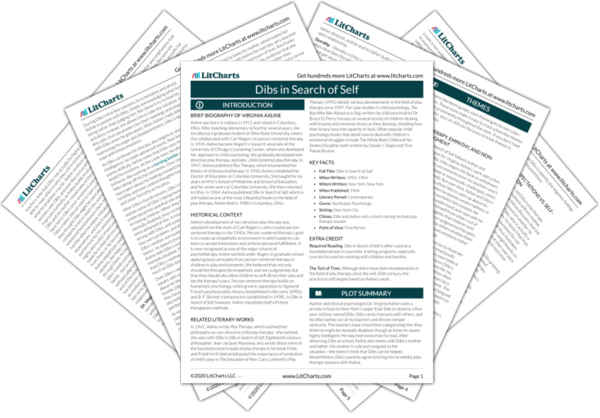Summary
Analysis
The next week, at Dibs’s 13th session, he notes that he and Axline only have three more sessions before they both go away for summer vacation. He also says that his grandmother is going to spend the summer with them this year. Dibs then picks up the girl doll and calls her a brat, saying that he’s going to get rid of her by poisoning her. Sometimes he’s afraid of Dorothy when she screams and hurts him, he says, and sometimes he scratches and hits her back. Dorothy was home this past weekend, and when Axline asks how that went, he says that he played with her and that they don’t fight much anymore.
Dibs’s interactions with the doll representing his sister are comparable to his interactions with the doll that represented his father. Now that his relationship with Dorothy is improving, Dibs is more open about his negative feelings about her. Just as he is doing with his father, Dibs is trying to build more trust and security in his relationship with Dorothy.
Themes
Dibs comments that Dorothy is going to attend his school next year. He’s glad that she’s coming home because she was probably very lonely at school. Dorothy doesn’t bother him like she used to; this weekend, Dibs read Dorothy a story that his father gave him. Dibs then pours some paint together and says that this is poison for his sister. Axline asks if the poison will mean the end of her if she eats it. Dibs nods, but then he says that he won’t give it to her just yet.
Just like Dibs’s play helps him work through feelings about his father, Dibs also works through feelings about his sister. Axline doesn’t judge Dibs for pretending to poison Dorothy. Instead, she understands that expressing this desire paradoxically indicates that Dibs is developing more trust and affection for his sister. In understanding and relaying his thoughts back to him, she helps him realize that he doesn’t in fact want his sister to disappear from his life; he recognizes the positive feelings that he has towards her.
Themes
Then Dibs moves the mother doll to the sandbox and instructs her to build a mountain, saying “don’t tell me you can’t do it.” He’ll show her how to build the mountain again and again, but she must do it. Then Dibs picks up the nursing bottle and says he’s just a baby who can’t do anything, instructing grandmother to “take care of baby.” When Dibs returns to the mother doll, he asks angrily why she doesn’t do what he says. He threatens that if she screams and cries, he’ll lock her in her room. According to Dibs, the mother is afraid to be locked in her room, so she tries to build the mountain.
In this passage, Dibs plays with the mother doll in a similar way to how he played with the father and sister dolls: he is trying to reverse their dynamic by holding her to impossible expectations, showing her how her expectations for him have made him feel sad, judged, and powerless. He expresses his love for his grandmother once more because she releases him from those expectations and allows him to act like a baby, which is symbolized by the nursing bottle and reflected in his childish language.
Themes
Dibs then returns to the doll representing Dorothy and holds her. He says that he’ll take care of her, holding the nursing bottle to her lips. Dibs explains that he’s going to make a gift for each of his family members at school and he wants to give his grandmother a piece of the branch from his favorite tree. He then picks up the mother doll from the sandbox and tells her that he’ll help her, that she doesn’t have to build a mountain. He puts her back in the dollhouse and sets everyone around the dining room table. Dibs starts to paint in bright colors, saying that the colors indicate happiness.
The more Dibs is able to express negative feelings toward his family members, the more his anger dissipates, leaving him able to express love and joy. Dibs is now even being empathetic towards Dorothy, whom he feels has no one to take care of her. He’s also empathetic towards his mother, seeming to sense that she, too, suffers from the burden of her own expectations. Using the nursing bottle with Dorothy illustrates that Dibs is setting aside his childish tendencies and displaying greater maturity and responsibility. He also shows his security by giving his grandmother the tree branch: whereas before, he used the branch to feel secure, now he has security in himself and he feels comfortable giving the branch away.
Themes
Get the entire Dibs in Search of Self LitChart as a printable PDF.

As the session concludes, Dibs says that he only has two more Thursdays after this one. He’ll miss Axline, and he remarks that it was a wonderful playroom. Axline notes that it had at times been a happy room, but that it had also held sorrow. Still, now Dibs has a sense of security. He can confront his feelings of hate and revenge and find mercy instead. Through his self-knowledge, he is now able to use his capacities and emotions more constructively.
Axline sums up the progress that Dibs has made in this passage. His trust in Axline and his feeling of freedom from judgment in the playroom allowed Dibs to build confidence and security in himself. Subsequently, Dibs’s sense of freedom in the playroom enabled him to express sorrowful feelings, but then allowed him to diminish those feelings and become a freer, happier child.
Themes












